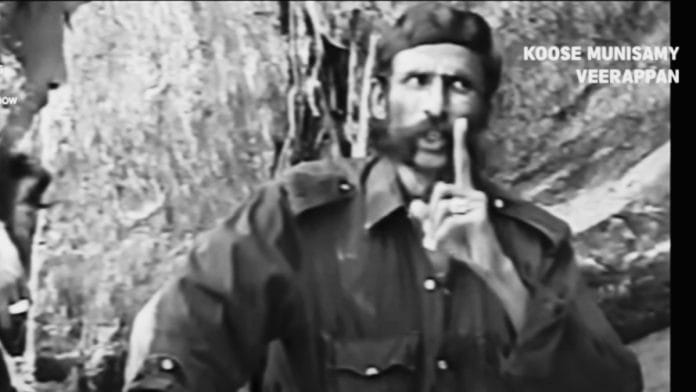New Delhi: Hero, brigand, bandit-king, wild animal, forest-king, brave – these are a few adjectives used to describe Koose Munasamy Veerappan, the well-known elephant poacher, sandalwood smuggler and man wanted for at least 120 murders in his lifetime.
Even in death, Veerappan’s portrayals across cinema, television shows and documentaries paint a complicated picture of an individual who is said to have killed nearly a quarter of the elephant population in Southern India.
“If someone was true to him, he was ready even to sacrifice his own life to save them. But if someone tries to betray him, he only thinks of taking their life,” said his wife Muthulakshmi in the Netflix documentary The Hunt for Veerappan (2023).
Veerappan, whose moustache became widely known across India, was an urban legend for children growing up in Kerala, Karnataka, and Tamil Nadu—a boogeyman parents used to threaten children into eating vegetables.
But for the authorities of the three state governments, Veerappan was more than that. He was known for targeting forest officials, kidnapping superstars and killing former legislators, becoming the focus of one of India’s most expensive manhunts for 12 years.
Born in 1952, Veerappan was killed on 18 October 2004 by the Tamil Nadu Special Task Force (STF). Rumours still swirl about how the police were able to finally find the smuggler, bring him out in the open and kill him. In death, he inspired a range of movies such as Killing Veerappan (2016) directed by Ram Gopal Varma, Attahasa (2013) directed by A.M.R Ramesh, and more recently the Netflix documentary and Koose Munisamy Veerappan (2023) on Zee5.
Criminal, hero, village elder
Born in the thick forests of Gopinatham in Chamarajanagar District in present-day Karnataka, Veerappan is said to have poached his first elephant at 14. He committed his first murder at the age of 17.
At 18, he joined his first gang and soon their business expanded from poaching of elephants for ivory to smuggling of sandalwood trees and eventually to abduction and ransoming.
In 1986, Veerappan was arrested by Karnataka police but magically escaped and continued his activities across the three states.
By 1991, he had killed police officers, forest officials and even had a Karnataka state Special Task Force out to arrest him. It was in this year when one of his more gruesome crimes came to light—the murder of forest officer P. Srinivas.
The case also highlights the complexities of Veerappan’s persona. Known for his care and affection for villagers, the ivory smuggler was enraged by Srinivas’ efforts to live and understand the issues surrounding Gopinatham.
“The other officials put forth their demands – they sought our help to catch Veerappan. He [Srinivas] had a different system. He cleaned our temple and renovated it. He built houses for those who did not have one, gave medicines to the sick, and drove expecting mothers to the hospital. He was a good man,” explained Selvi and K. Munusamy, residents of Gopinatham village in the Netflix documentary.
For Muthulakshmi, however, this was just an act—a performance that unsettled her husband. Veerappan’s anger at Srinivas’ efforts to understand and help the villagers of Gopinatham eventually led to the forest officer’s killing.
Over time, Veerappan became more than a brigand—he was a troubleshooter, handling the problems faced by the villagers, de-escalating tiffs, and solving issues that were normally handled by the panchayats.
Also read: ‘Wrestlers have to manage on their own’ in India—What Dara Singh told Nehru
Sandalwood smuggler and his end
Veerappan and his gang, which numbered nearly 150 at one point in time, focused on the smuggling of sandalwood trees. The cutting and sale of sandalwood was a monopoly of the Karnataka government.
Smuggling brought crores to Veerappan and his gang, with some estimates indicating his operations made millions of dollars. However, the special task forces had an impact over time, whittling away his gang through consistent raids to prevent further smuggling of sandalwood.
“You make a bed out of sandalwood for the Chief Minister, then how did you cut that tree and get the wood? When you [the government] do it, it is not wrong, but if I do it for my livelihood, then it is wrong,” explained Muthulakshmi of Veerappan’s opinion for continuing in the sandalwood smuggling business.
This view found favour among villagers in search of money and a better life, and with Veerappan’s apparent care and affection, his fame only grew. His end came when he stepped out of the forest for medical treatments. The police ambushed the smuggler and finally killed him in October 2004.
Two decades after his death, the infamous elephant poacher has become a permanent fixture in popular culture and true crime stories.
(Edited by Ratan Priya)






